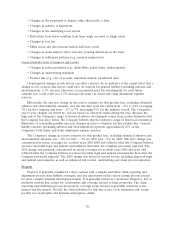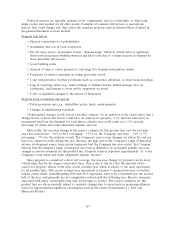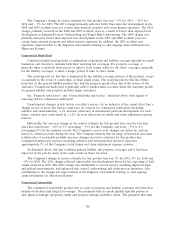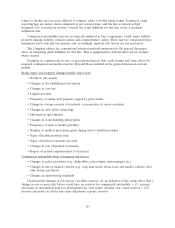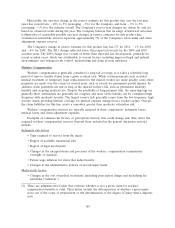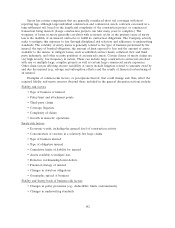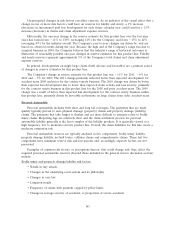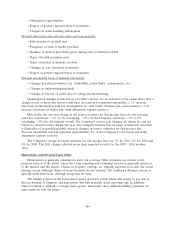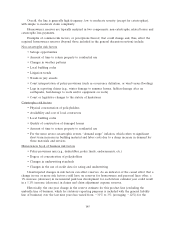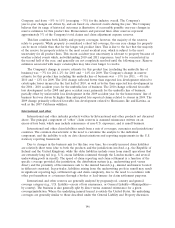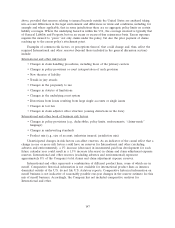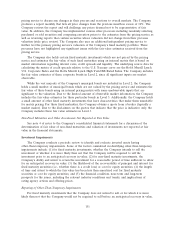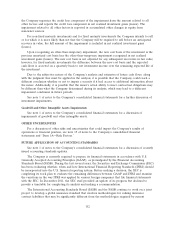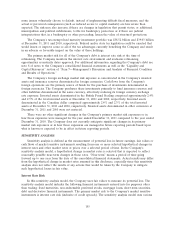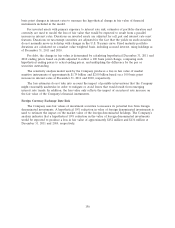Travelers 2011 Annual Report Download - page 158
Download and view the complete annual report
Please find page 158 of the 2011 Travelers annual report below. You can navigate through the pages in the report by either clicking on the pages listed below, or by using the keyword search tool below to find specific information within the annual report.
Company, and from 8% to 11% (averaging 3%) for the industry overall. The Company’s
year-to-year changes are driven by, and are based on, observed events during the year. The Company
believes that its range of historical outcomes is illustrative of reasonably possible one-year changes in
reserve estimates for this product line. Homeowners and personal lines other reserves represent
approximately 3% of the Company’s total claims and claim adjustment expense reserves.
This line combines both liability and property coverages; however, the majority of the reserves
relate to property. While property is considered a short tail coverage, the one year change for property
can be more volatile than that for the longer tail product lines. This is due to the fact that the majority
of the reserve for property relates to the most recent accident year, which is subject to the most
uncertainty for all product lines. This recent accident year uncertainty is relevant to property because of
weather related events which, notwithstanding 2010 and 2011 experience, tend to be concentrated in
the second half of the year, and generally are not completely resolved until the following year. Reserve
estimates associated with major catastrophes may take even longer to resolve.
The Company’s change in reserve estimate for this product line (excluding the umbrella line of
business) was 7% for 2011, 2% for 2010 and 14% for 2009. The Company’s change in reserve
estimate for this product line including the umbrella line of business was 11% for 2011, 4% for
2010 and 12% for 2009. The 2011 change reflected better than expected loss development related to
catastrophe losses incurred in the first half of 2010, as well as better than expected loss development in
the 2006 - 2010 accident years for the umbrella line of business. The 2010 change reflected favorable
loss development in the 2008 and prior accident years, primarily for the umbrella line of business,
partially offset by unfavorable loss development in the 2009 accident year for the homeowners’ line of
business that was driven by higher than anticipated late-reported claims related to storms in 2009. The
2009 change primarily reflected favorable loss development related to Hurricanes Ike and Katrina, as
well as the 2007 California wildfires.
International and other
International and other includes products written by International and other products not discussed
above. The principal component of ‘‘other’’ claim reserves is assumed reinsurance written on an
excess-of-loss basis, which may include reinsurance of non-U.S. exposures, and is runoff business.
International and other claim liabilities result from a mix of coverages, currencies and jurisdictions/
countries. The common characteristic is the need to customize the analysis to the individual
component, and the inability to rely on data characterizations and reporting requirements in the U.S.
statutory reporting framework.
Due to changes in the business mix for this line over time, the recently incurred claim liabilities
are relatively short term (due to both the products and the jurisdictions involved, e.g., the Republic of
Ireland and the United Kingdom), while the older liabilities include some from runoff operations that
are extremely long tail (e.g., U.S. excess liabilities reinsured through the London market, and several
underwriting pools in runoff). The speed of claim reporting and claim settlement is a function of the
specific coverage provided, the jurisdiction, the distribution system (e.g., underwriting pool versus
direct) and the proximity of the insurance sale to the insured hazard (e.g., insured and insurer located
in different countries). In particular, liabilities arising from the underwriting pools in runoff may result
in significant reporting lags, settlement lags and claim complexity, due to the need to coordinate with
other pool members or co-insurers through a broker or lead-insurer for claim settlement purposes.
International and other reserves are generally analyzed by program/pool, country and general
coverage category (e.g., U.S. Liability—excess of loss reinsurance, or General Liability—Municipalities—
by country). The business is also generally split by direct versus assumed reinsurance for a given
coverage/jurisdiction. Where the underlying insured hazard is outside the United States, the underlying
coverages are generally similar to those described under the General Liability and Property discussion
146


